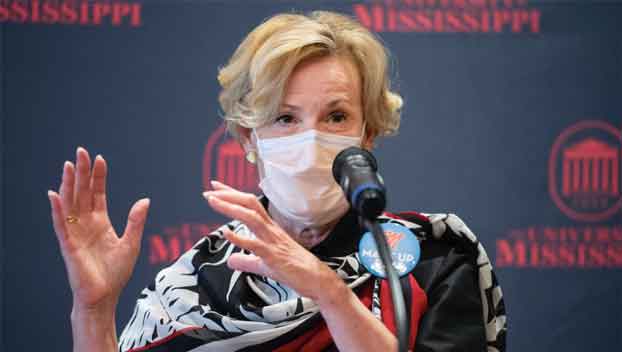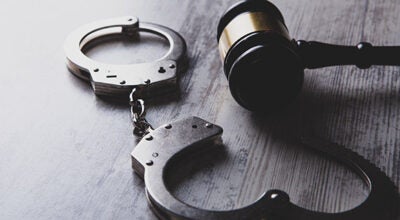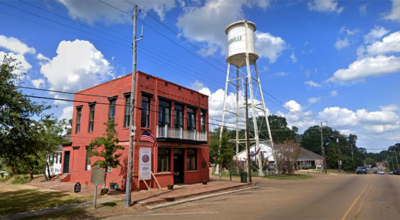White House coronavirus expert asks Ole Miss students to get parents to wear masks
Published 7:04 pm Saturday, September 12, 2020

- Dr. Deborah Birx of the White House Coronavirus Task Force speaks at a news conference during her visit on Saturday, Sept. 12, 2020 to the University of Mississippi. (Logan Kirkland/ Ole Miss Digital Imaging Services)
The City of Oxford and University of Mississippi received words of encouragement and the message of staying the course in their COVID-19 response plans on Saturday.
Dr. Deborah Birx, a member of the White House Coronavirus Task Force, met with Chancellor Glenn Boyce and Mayor Robyn Tannehill to discuss how the University and city have handled the coronavirus pandemic, along with a spike in cases, since students returned to campus last month.
With new cases and hospitalization rates trending down across the state, Lafayette County has continued to be a hotspot in recent weeks, setting record highs in new daily cases a couple of weeks ago. In spite of the increasing numbers, Birx commended the efforts made by Tannehill and the Board of Aldermen since the pandemic hit Lafayette County in March.
“I think starting the (mask mandate in April) was proactive,” Birx said. “I think that was understanding the data. I think that was understanding what was important for the community.”
Roughly eight weeks ago, Mississippi was considered a red zone, or hotspot state, with over 60 counties having over a 10-percent positive test rate, according to Birx. In the last five weeks, that number has dropped to 23 counties. Statewide, the positivity rate has dropped from 17 percent to eight percent.
Lafayette County reported 25 new cases on Saturday, making up five percent of the new cases reported by the Mississippi State Department of Health on Saturday. As of Sept. 10, Lafayette County had 337 active cases, according to COVID-19 data on the City of Oxford website.
Birx spoke with both Boyce and Tannehill regarding bringing back students for the fall semester, as well as keeping businesses and restaurants open.
“We had very clear and concise dialogue about, really, a way forward. But, the entire South has shown us a way forward with this virus,” Birx said. “With what Mississippi has been able to do just over the last four to five weeks shows us, that if we change our behavior and wear a mask and we social distance and we wash our hands and we really take care of others, there’s a pathway forward that maintains (keeping) retail open. It maintains Universities and it maintains schools open. But, it takes all of us working together to really protect the community.”
The Oxford Board of Aldermen met on Sept. 8 and voted to keep in place the ordinance ending service at all bars and restaurants at 10 p.m. However, they also voted to keep those establishments open until 11 p.m. on Friday and Saturday nights during Ole Miss home football game weekends.
“There were several things that we discussed this morning,” Tannehill said of her meeting with Birx. “I don’t know how much new information it was, because I have listened to her throughout this pandemic, but it was reassuring to hear her say that she believes that the plan that we have in place is effective. Instead of people closing back down, that you have to find ways to work through these rises in cases. She does not recommend shutting back down as far as businesses go.”
The crux of Birk’s visit was to speak with Boyce regarding the COVID-19 active cases among the UM community, primarily among the student population.
When school started on Aug. 24, the University reported more than 300 active cases among students, faculty and staff. Over the past week, that number steadily declined, with 106 active cases being reported by the University’s COVID-19 dashboard as of Saturday morning. One hundred five cases are among students and one case is among University staff, as of Saturday morning.
Other colleges across the country, most notably Notre Dame and the University of North Carolina, shifted to only virtual learning after the first week of in-person classes.
According to Boyce, Ole Miss has not reached any threshold barriers the University has set in place, and administration is monitoring several factors that are included on the dashboard, such as active cases and the quarantine and outbreak numbers that would warrant closing down campus.
“We’re tracking many metrics,” Boyce said. “So, there’s not one threshold that says, ‘Alright, we’ve reached this threshold. That’s it, we’re closing down.’ We’re tracking quarantine space. We’re tracking isolation space. Everything we’re tracking is right there on the dashboard. We’re trying to be as transparent as possible.
“We’re also keeping close contact with our hospital, making sure they have space in case hospitalizations occur. Now, obviously the age group that’s most impacted right now, there has not been a lot of hospitalizations.”
As of Saturday morning, there were 13 people in isolation and 26 others in quarantine. The numbers being tracked on the dashboard are only individuals living in on-campus housing and using the designated quarantine or isolation housing the University has set aside. The number also counts anyone in off-campus housing who does not have the ability to isolate or quarantine on their own and are using the housing. Students who are quarantining in off-campus housing are not included in the numbers.
Provost Noel Wilkin, who was also present during Saturday’s media availability, noted somewhere between 300 to 400 students have been quarantined at some point since the University started its quarantine procedure.
On Friday, Birx said she went to the Downtown Square, and commented on seeing many students following the mask mandate that Oxford’s Board voted into law last month, which requires masks to be worn outdoors where social distancing is not possible, mostly in areas where people are waiting in lines to eat around the Square. According to Birx, not everyone was following that mandate.
“I want to thank the students of Ole Miss, because I saw a lot of students in masks. However, their parents were not,” Birx said. “So, I ask every student at Ole Miss, get your parents to wear a mask when they come to the town of Oxford. Really, we need to increase (mask wearing), and talk to them about wearing masks at home. I think the students can have a great impact on their parents and their parents’ behavior changes, too. Really, the students can be a real voice to get a message across.”





